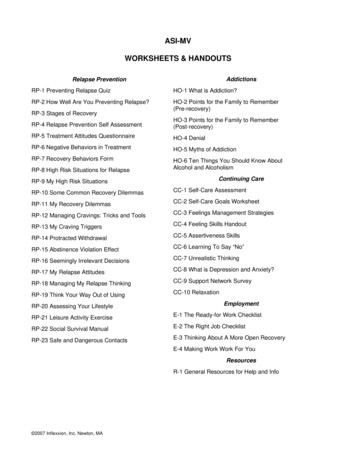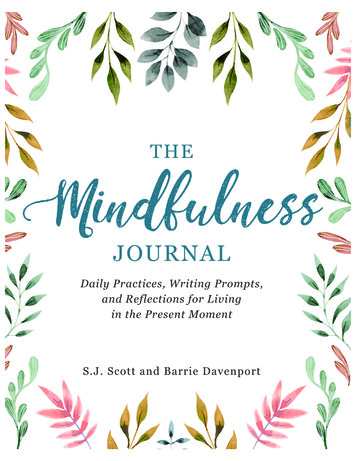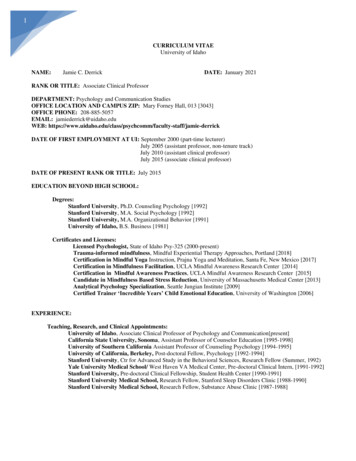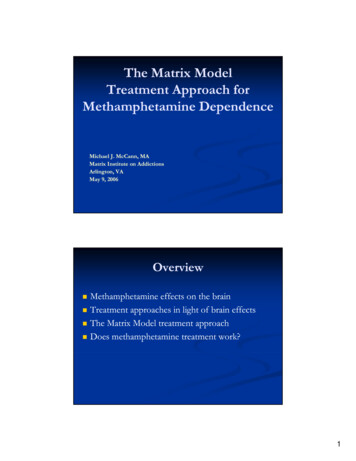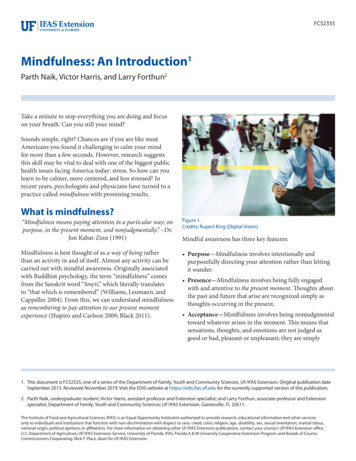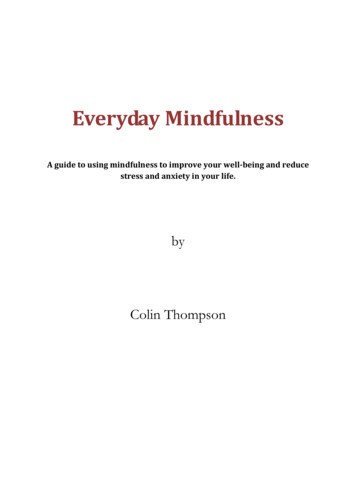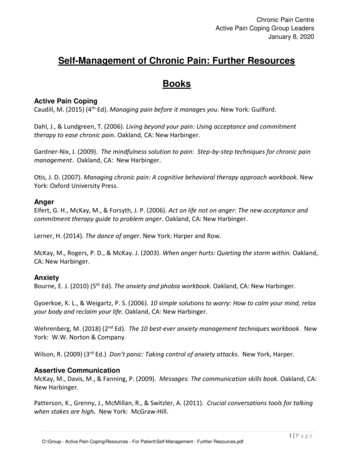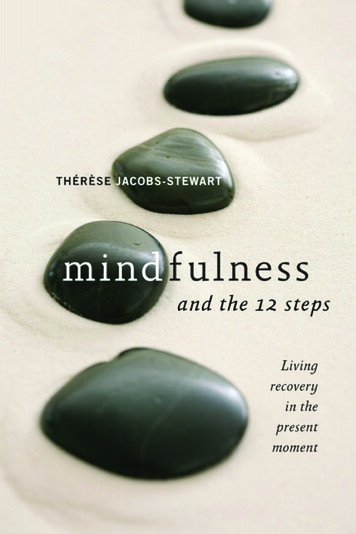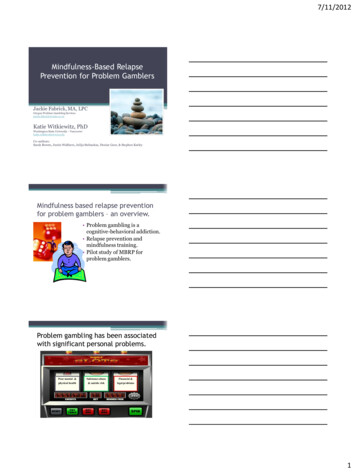
Transcription
7/11/2012Mindfulness-Based RelapsePrevention for Problem GamblersJackie Fabrick, MA, LPCOregon Problem Gambling Servicesjackie.fabrick@state.or.usKatie Witkiewitz, PhDWashington State University - Vancouverkatie.witkiewitz@wsu.eduCo-authors:Sarah Bowen, Justin Walthers, Julija Stelmokas, Denise Gour, & Stephen KeeleyMindfulness based relapse preventionfor problem gamblers – an overview. Problem gambling is acognitive-behavioral addiction. Relapse prevention andmindfulness training. Pilot study of MBRP forproblem gamblers.Problem gambling has been associatedwith significant personal problems.Poor mental &physical healthSubstance abuse& suicide riskFinancial &legal problems1
7/11/2012Problem gambling is a progressiveaddiction characterized by: increasing preoccupation with gamblinga need to bet more money more frequentlyrestlessness or irritability when attempting to stop"chasing" lossesloss of control manifested by gambling behavior inspite of mounting, serious, negative consequences.Gambling in OregonMoore, T. (2006). Oregon Gambling Addiction Treatment Foundation.Gambling in OregonMoore, T. (2012). Oregon Health Authority, Addictions and Mental Health Division.2
7/11/2012Gambling Treatment in Oregon Treatment is free and confidential for Problem Gamblers Family Member FY 2010-2011 1209 Problem Gamblers 145 Family MemberGambling Treatment in Oregon Outpatient treatmentResidential treatmentRespite careHelplineGEARPreventionEffective treatments for problemgambling have been studied. Gamblers Anonymous Pharmacotherapy Opioid antagonists, antidepressants, lithium Cognitive and cognitive behavioral therapy Brief and motivational interventionsReviewed by Petry (2009). Cognitive and Behavioral Practice, 16, 457-467.3
7/11/2012Lapse and relapse rates forpathological gambling are high. Psychological factors Coping skills Cognitions and affect Personality Physiological arousal Craving and withdrawal Social factorsWhat is Relapse?Any gambling Relapse Black-and-White Model: Cognitive-Behavioral Model:AbstinenceLapse: singleinstance of gamblingRelapse: falling back topretreatment levels ofgambling behaviorMultiple LapsesHow Does Relapse Happen?The Cognitive Behavioral ModelEffectiveCoping ResponseDecreasedProbabilityof ffectiveCopingResponseDecreasedSelf-Efficacy nEffectIncreasedProbabilityof Relapse(for initial effectsof gambling)Marlatt & Gordon, 19854
7/11/2012Relapse Prevention is an effectivetreatment across disorders. Alcohol (Kadden et al., 1992; Monti et al., 2002)Cocaine (Schmitz, et al., 2001)Marijuana (Roffman, et al., 1990)Smoking (Killen, et al., 1984)Eating disorders (Mitchell & Carr, 2000)Gambling (Echeburua, et al., 2000)Sexual Offenses (Laws, 1995)(Irvin, et al., 1999; Carroll, 1996)Review of 24 Randomized Trials(Carroll, 1996) Does not prevent a lapse, but is more effective at delayingand reducing duration and intensity of lapses Effective at maintaining treatment effects over long termfollow-up (1-2 years or more) May be most effective for greater levels of negative affectEnhancing Relapse Preventionwith Mindfulness Training5
7/11/2012What is Mindfulness?“Awareness that emerges through paying attention onpurpose, in the present moment, and non-judgmentally tothe unfolding of experience moment by moment”(Kabat-Zinn, 2003)MINDFULNESS EXERCISEMindfulness Meditation?Meditation practice associated with increased attentional control improved physical health and immune function enhanced self-awareness greater self-regulation of emotional reactions reductions in perceived stress6
7/11/2012Mindfulness and Substance UsePaying attention:In the present moment Accepting present experience,rather than “getting a fix” toavoid the present experienceGreater awareness oftriggers and responses,interrupting previouslyautomatic behaviorNonjudgmentally:Detach from attributions and “automatic”thoughts that often lead to relapse19Mindfulness-Based Relapse Prevention(MBRP)MBRP Structure Integrates mindfulness with Relapse Prevention Patterned after Mindfulness-Based Stress Reduction (KabatZinn, 1990) and Mindfulness-Based Cognitive Therapy fordepression (Segal et al. 2002) Outpatient Aftercare Treatment 8 weekly 2 hour sessions; daily home practice Therapists have ongoing meditation practice Components of MBRP Formal mindfulness practice Informal practice Coping strategies(Bowen, Chawla & Marlatt, 2010; Witkiewitz et al., 2005)7
7/11/2012Intentions of MBRPAwareness:From “automatic pilot” to awareness and choiceTriggers:Awareness of triggers, interrupting habitual reactionsAcceptance:Change relationship to discomfort, decrease need to“fix” the present momentBalance and Lifestyle:Supporting recovery andmaintaining a mindfulnessMBRP Session ThemesSession 1: Automatic Pilot and RelapseSession 2: Awareness of Triggers and CravingAwareness,PresenceSession 3: Mindfulness in Daily LifeSession 4: Mindfulness in High-Risk SituationsSession 5: Acceptance and Skillful ActionMindfulnessand RelapseSession 6: Seeing Thoughts as ThoughtsSession 7: Self-Care and Lifestyle BalanceSession 8: Social Support and ContinuingPracticeBigger Picture:A Balanced Life“Formal” PracticesBody ScanMindful MovementSitting Meditation“Lovingkindness” or “metta”Mountain MeditationWalking Meditation8
7/11/2012MINDFULNESS EXERCISEPracticing MindfulnessMind onchosen targetPresentMomentObservewandering,begin y“If your attention wanders ahundred times, simply bring itback a hundred times.”InquiryPainEmotionalin left ectExperience(pain)“I can’t handle this. I“I can’t do this”need an escape.”Reactions, Stories,Judgment(suffering)Adapted from Segal et al., 20029
7/11/2012“Informal” PracticesMindfulness ofdaily activitiesHourglass breathing spaceUrge surfingHourglass Breathing SpaceUrge Surfing Exercise“Picture the urge as an ocean wave, and imagine yourself surfing,using your breath as the surfboard ”Bowen, Chawla & Marlatt (2010)10
7/11/2012Riding the wave, rather thangiving into the urge and beingwiped out by it.Staying with the urge as itgrows in intensity, riding it toits peak, using the breath tostay steady as it rises andcrests, knowing it willsubside.Trusting that without anyaction on your part, all thewaves of desire, like waves onthe ocean, arise andeventually fade away.urgetimeAwareness of TriggersSituation/TriggerAnargumentwith mygirlfriend.Whatsensations didyouexperience?Tightnessin chest,sweatypalms,heartbeatingfast, shakyall overWhatWhatmoods,thoughtsfeelings orarose?emotions didyou notice?Anxiety,hurt,angerWhat didyou do?“I can’t do Yelled,this.”slammed“I need adrink.”door, wentfor a walk“Forget it.I don’tcareanymore”11
7/11/2012Relapse CycleSTOPTriggerObserveReactionRespond , lapse)Buy nsRELAPSEFacilitating MBRPMotivational Interviewing styleAcceptance, openness, curiosity,kindness, authenticityPersonal meditation practiceEmbodiment of these qualitiesSpontaneity and creativityMBRP Pilot Efficacy Trial MBRP vs. treatment as usual control group N 168, from community service agency 64% male, average age 40 52% white, 29% African American, 8% Native American 46% alcohol, 36% crack, 14% meth, 7% opiates, 19% polysubstance Assessments at post-treatment, 2- and 4-month follow-upsNIDA R21-DA019582 (Marlatt, PI)12
7/11/2012Individuals assigned to MBRP had significantlyfewer substance use days post-treatment.*Bowen et al. (2009). Substance Abuse.Individuals in MBRP reported significantly lesscraving over time.Time x treatment: p .02Time2 x treatment: p .02Bowen et al. (2009). Substance Abuse.Depression Scores End of TreatmentNo significant differences in depression scores.13
7/11/2012Moderating effect of MBRP on association betweendepression scores and substance use days.f 2 .18Witkiewitz & Bowen (2010) J. Consulting & Clinical PsychologyMechanism of change? MBRP reduces the relation between depressionsymptoms and substance use Why? MBRP designed to help clients experience challengingemotions without reacting Altered the conditioned response of substance cravingin response to negative affectMBRP works for substance usedisorders – could it work for gambling?14
7/11/2012Mindfulness-based treatments may beeffective for problem gambling. Evidence in support of MBRP for substance use. Case study by de Lisle, Dowling & Allen (2011):Current study – a pilot investigation ofMBRP for problem gamblers. Collaboration between MBRP andgambling treatment providers toadapt MBRP manual (Bowen et al.,2011) to be gambling specific. Clients recruited from InAct, agambling treatment program.Pilot Study of MBRP-PG 8-week MBRP program Assessments at baseline, 4-weeks, and 8-weeks. Participants (n 11) recruited from InAct 36.4% female Average age 53.1 (SD 9.9), range 35-69 8 enrolled in treatment (73%) and completed midtreatment assessment 6 completed treatment and post-treatmentassessment (75%)15
7/11/2012Measures Neuropsychological battery Shipley Institute of Living Scale Gambling behavior National Opinion Research Center DSM-IVsymptoms of pathological gambling (NODS) Mindfulness Mindfulness Practice QuestionnaireShipley Institute of Living Scale - 2 Brief measure of crystallized, fluid intelligence Provides estimate of overall intelligence, as wellas cognitive impairment/deterioration Current sample: Standard score: Mean 99.1 (SD 17.2) Range 67 (1%) – 116 (86%)Primary Research Questions Is MBRP effective in reducing gamblingsymptoms? Does cognitive functioning predict treatmentretention, mindfulness practice, and/orgambling outcomes?16
7/11/2012ResultsDSM-IV Symptoms of Pathological Gambling** p 0.05ResultsWeekly mindfulness practiceResultsCognitive functioning and treatment retention** p 0.0517
7/11/2012ResultsCognitive functioning and mindfulness practice*r 0.78; p 0.02r 0.69; p 0.13Results: Additional Findings Gambling symptoms at mid- and posttreatment No association with baseline Shipley scores. Negative, but not significant, association withmindfulness practice.Overall, promising preliminary results.TreatmentretentionMBRPresulted ractice18
7/11/2012Limitations Small sample size No control group Only one test of cognitive functioning Unable to examine effects by gender, race, or ageFuture Directionsfor MBRP-PG Examine interaction between cognitive functioning andmindfulness practice in predicting gambling outcomes. Research design considerations. Compare MBRP-PG to active treatment group. Longer follow-up and more comprehensive assessment.Future Directionsfor MBRP Is this for everyone? Gender Dependence severity Dual diagnosis (depression, anxiety, trauma) Long term effects? Physiological and neurobiological effects19
7/11/2012Future Directionsfor MBRP Next steps for Oregon Grant application Training ImplementationResources MBRP website: www.mindfulrp.comMindfulness-Based Relapse Prevention forAddictive Behaviors: A Clinician’s GuideGuilford Press, November 2010AcknowledgementsMBRP-PGparticipantsMBRP FacilitatorsDenise GourStephen KeeleyTreatment ProvidersOregon Problem GamblingInAct – Oregon VOARecovery Centers of King CountyMBRP-PG Research Team:Katie WitkiewitzJustin WalthersSarah BowenJulija StelmokasMBRP Research Team:Alan Marlatt, PhDSarah Bowen, PhDKatie Witkiewitz, PhDNeha Chawla, PhDSeema Clifasefi, PhDSusan Collins, PhDJoel Grow, MSBrian Ostafin, PhDMary Larimer, PhDKathy Lustyk, PhD20
7/11/2012Thank you!21
Smoking (Killen, et al., 1984) Eating disorders (Mitchell & Carr, 2000) Gambling (Echeburua, et al., 2000) Sexual Offenses (Laws, 1995) (Irvin, et al., 1999; Carroll, 1996) Review of 24 Randomized Trials (Carroll, 1996) Does not prevent a lapse, but is more effective
